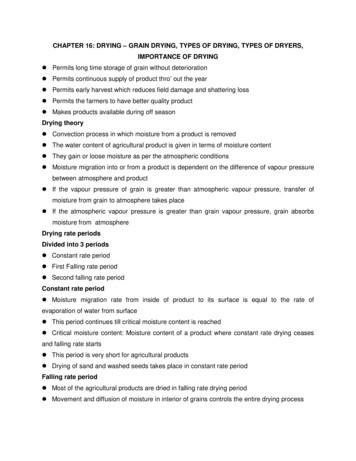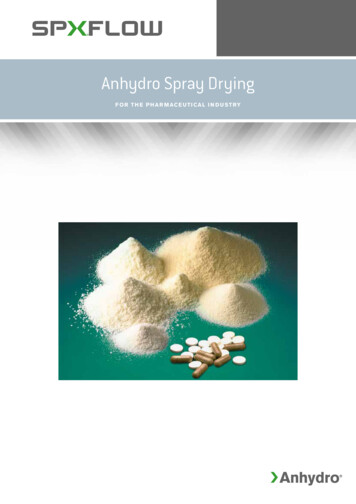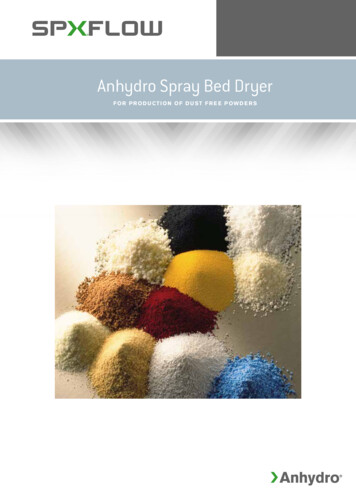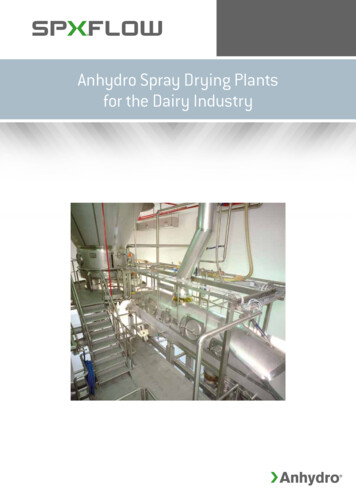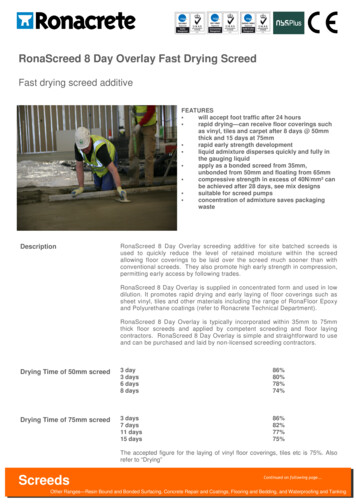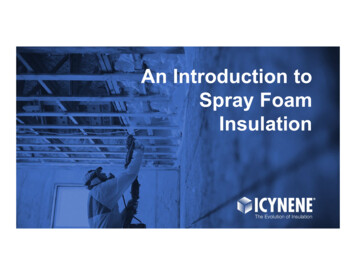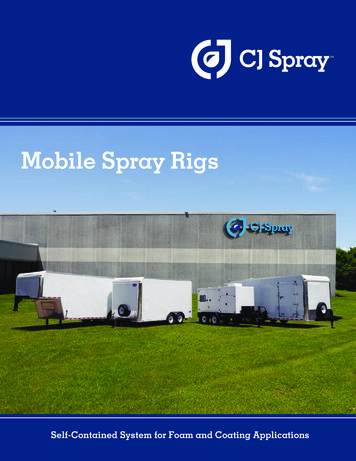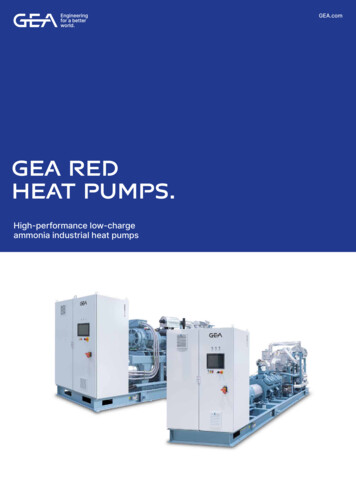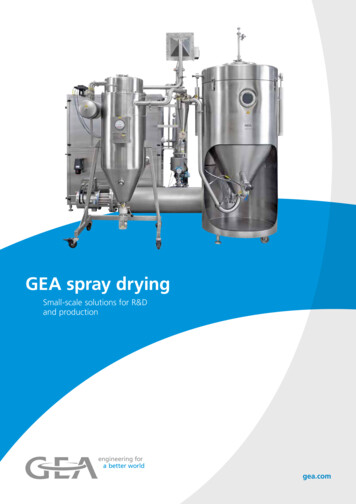
Transcription
GEA spray dryingSmall-scale solutions for R&Dand production
2·SMALL-SCALE SOLUTIONSExpect moreCONTENTExpect more02Process and equipment expertise03Atomization04ConfigurationsMOBILE MINORIt all adds to your success,expertise, equipment andsupport0506 PRODUCTION MINOR 08VERSATILE-SD 10Closed-cycle spray drying12Getting it right from the startFSD and FSD Granulator14With more than 3,000 references for spray drying plantsProcess control16for R&D and small production units, GEA has unmatchedCleaning solutions17expertise within small-scale spray drying technology. Which Environmental, health and safetyrequirementsmeans that we have the know-how to help you choose exactly18the right process and equipment. Many of the world’s leadingmanufacturers and their R&D departments, independentresearch centers and universities work with GEA, and they allgain from our process and product knowledge.There when you need usWe are a truly global supplier, but we believe service is a localbusiness. With GEA, you never have to go far for assistance orovercome time or language barriers. We are there whenever andwherever you need us. And not just with representatives, butwith our own staff, stocks of spare parts and service engineers.Flexible solutionsWorking with GEA gives you access to the most advanced spraydrying technology on the market. We offer versatile, multipurpose plants for the food, dairy, chemical and pharmaceuticalindustries.Single particlesAgglomeratesGranulates
SMALL-SCALE SOLUTIONS·3Process and equipment expertiseTesting and spray drying solutionsThe world’s largest pool of talent specialized in tacklingAnalytical accuracy maximizes performancespray drying challengesOur capabilities include single droplet drying applied to testWant a drier powder? An easier flowing powder? Agglomeratesthe feasibility of spray drying and to address basic formulationwith fewer fines? With more than 35 pilot plants in GEA testquestions at a very early stage of the development phase. Withcenters worldwide and an international team of test engineersGEA’s DRYING KINETICS ANALYZER , it is possible toand process technologists, GEA represents the world’s largestconduct exploratory tests with only a few milliliters ofpool of talent specialized in spray drying. We provide powdermaterial available.engineering expertise and process verification through laboratoryand pilot plant testing. We also offer the industry’s mostThis technique also allows real-world measurements (e.g. dryingadvanced analytical capabilities, including dynamic flowtime of a given feed) to be incorporated into Computational Fluidmodelling based on the drying properties of a single droplet.Dynamics (CFD) simulations. This makes it possible to establishthe spray dryer performance by precisely analyzing the resultsof single droplet drying experiments. GEA’s DRYNETICS analysis is used to investigate product formulations, and tooptimize spray drying plant designs – for new or existing spraydrying plants.MoistureDRYNETICS ANALYSIS BY GEATime1 S INGLE DROPLET EXPERIMENTS Temperature Size and position MorphologyTime2A DVANCED DATA ANALYSIS Drying kinetics Density StickinessDrying chamber3 CFD SIMULATIONS Velocities Temperatures Moisture Deposits
4·SMALL-SCALE SOLUTIONSAtomizationDifferent atomization modesOne of the most important choices in a plant configuration is choosing the rightatomization and powder discharge method. We offer a wide range of solutions, asillustrated.Rotary atomizerIn rotary atomization, the feed is centrifugally accelerated to high velocity in theatomizer wheel before being discharged into the hot drying gas. The degree ofatomization and particle morphology depends upon peripheral speed, feed rate,liquid properties and atomizer wheel design. Particle size is adjusted by changing theperipheral speed. The rotary atomizer, considered the most flexible atomizing device,is suitable for a wide range of products. Rotary atomizers will generally deliver anarrower particle size distribution and more free flowing powder than two fluid nozzles.Rotary atomizerTwo-fluid nozzle, co-current or fountain modeTwo-fluid nozzle atomization is achieved pneumatically by high-velocity compressedair/gas impacting the liquid feed. Particle size is controlled by varying the nozzle flowratio between atomizing gas and feed. When operating in co-current mode, the nozzletip is placed close to the outlet of the ceiling air disperser. The co-current mode isselected when drying heat-sensitive products. When coarse particles of a non-heatsensitive feed are required, the two-fluid nozzle in fountain mode is appropriate.Co-current nozzlePressure nozzle, co-current or fountain modeWith a pressure nozzle, atomization is the result of the conversion of pressure energywithin the liquid feed into kinetic energy of a moving thin liquid sheet. Pressureapplied to the liquid within the nozzle forces the liquid out of the orifice creating theatomization. A pressure nozzle can be operated in co-current mode or in fountainmode. Particle size is adjusted by changing the feed pressure and nozzle size. Pressurenozzles will generally deliver a narrower particle size distribution and coarser particlesthan other atomizer types.Fountain nozzleCOMBI-NOZZLETM(patented)In some applications, there is a need for both narrow particle size distribution andsmall particle size. GEA has developed the COMBI-NOZZLE , which combines thebest features of pressure nozzles and two-fluid nozzles. As an added benefit, the energyconsumption will typically be less than for a conventional two-fluid nozzle.Please noteFor operation with feeds based on flammable solvents or powders subject to explosionrisk, dedicated designs are available.COMBI-NOZZLE
SMALL-SCALE SOLUTIONS·5ConfigurationsWhen configuring a plant, it is essential to choose the mostPARTICLE SIZE DISTRIBUTIONappropriate mode of operation, equipment design and powderwith different atomization systemsunder comparable conditionscollection system. We offer a wide range of solutions andconfigurations to meet your specific requirements.Frequency1. Open-mode designmode designFeedInlet gasParticle size (µm)Outlet gas4060Two-fluid nozzle,co-currentTwo-fluidnozzle,co-currentRotary atomizer, co-currentRotaryatomizer, co-currentPressure nozzle, co-current80Two-fluid nozzle, fountain modePressure nozzle, fountain modeCombi-nozzlePressure nozzle, co-currentMain powderfractionTwo-fluid nozzle, fountain modeDustPressure nozzle, fountain modeCOMBI-NOZZLE 2. Multi-stagedryingdryingdesign designMulti-stageOutlet gasFrequencyFrequencyFeedInlet gasDustInlet gas3-chamberintegratedfluid bedInlet gasInlet gasMain powderfractionClosed-cycle design3. Closed-cycle designFeedN² inN² outCoolingmediumin/outMain powderfractionDustSolventParticle size (µm)Part
6·SMALL-SCALE SOLUTIONSMOBILE MINOR Multi-purpose spray dryerThe MOBILE MINOR is the perfect choice for carrying out test work and exploringthe possibilities of spray drying. It meets the demand for a safe, sanitary, flexible,modern and easy-to-handle laboratory spray dryer. In the MOBILE MINOR , smallquantities of solutions, suspensions or emulsions can be dried into representativepowder samples, and the process data required for scale-up to industrial productioncan be retrieved.GEA has developed 5 different types of the MOBILE MINOR in order to accommodate ourcustomers’ different requirements.The MOBILE MINOR has a pneumatically liftablechamber roof for easy inspection and cleaning.MOBILE MINOR (Std.) Location in a non-classified zoneAqueous feedMOBILE MINOR (PSR) Location in a non-classified zone Pressure shock resistance Dust explosion protection for class St 1 and 2 productsMOBILE MINOR (I) Location in a non-classified zone Inert process gas supply – nitrogen once through Dust explosion protection by inertingMOBILE MINOR (EEx) Inert process gas supply EEx-classified Location of plant in ATEX zone 1/22 ECP located in non-classified zone Explosion protection by inertingOrganic solvent based feedMOBILE MINOR (CC) Inert process gas supply EEx-classified Closed-cycle design Location of plant in ATEX zone 1/22 ECP located in non-classified zone Explosion protection by inerting
SMALL-SCALE SOLUTIONSMOBILE MINOR Water evaporation (kg/h)co-currentatomizationTwo fluid nozzleco-current atomization10987654321503530Outlet temperature 80 COutlet temperature 90 COutlet temperature 100 COutlet temperature 110 C100 150 200 250 300 350Inlet Temperature ( C)Key figuresMOBILE MINOR Nominal main process gas flow (kg/h)100Water evaporation capacity (kg/h)0.5 – 8Typical mean particle size (µm)5 – 80Space requirements, L W H (m)2.5 2 2.3Options Rotary atomizer Flame arrester Two-fluid nozzle Cartridge filter Feed pump Bag filter(manual/automatic) Wet scrubber Pneumatic hammer HEPA filter Explosion membrane Extra data logging Explosion suppression CIP systemssystem2520151050·7
8·SMALL-SCALE SOLUTIONSPRODUCTION MINOR and VERSATILE-SD GEA’s PRODUCTION MINOR and VERSATILE-SD belong toPRODUCTION MINOR makes it suitable for a wide range ofa range of versatile production-scale spray drying units. Theyproducts. It is a standard spray dryer in a sanitary design withcan be used in the production of a wide range of products – fromseveral modules and options available.advanced ceramics and catalysts to flavors, herbal extracts andThe VERSATILE-SD spray dryers are modular spray dryersfood ingredients.designed to utilize the same modules and configurations forThe PRODUCTION MINOR is a flexible spray dryer that can bedifferent capacity levels and product requirements. With severalused for both R&D – where a larger capacity is required –modules and options available, they can be designed to meetand for small-volume productions. The capacity of thealmost every customer requirement. VERSATILE-SD , size 12.5 with bag filter
SMALL-SCALE SOLUTIONS·PRODUCTION MINOR Two fluid nozzleco-currenttwo-fluid-nozzle atomizationco-current atomizationWater evaporation (kg/h)3535Key figures3025Outlet temperature 80 C2015Outlet temperature 90 C10Outlet temperature 100 C550Outlet temperature 110 C100 150 200 250 300 350PRODUCTION MINOR 3025Nominal main processgas flow (kg/h)20Water evaporationcapacity (kg/h)105 – 30510 – 90Typical mean particle size (µm)0Space requirements, L W H (m)Inlet Temperature ( C)360154.4 2 2.7VERSATILE-SD , size 6.3co-current pressure atomizationVSD-6.3 co-current atomizationer evaporation (kg/h) Water evaporation (kg/h) Water evaporation (kg/h) Water evaporation (kg/h) Water evaporation (kg/h) Water evaporation (kg/h) Water evaporation (kg/h) Water evaporation (kg/h)60Key figures50VERSATILE-SD size 6.340Outlet temperature 80 CNominal main process gas flow (kg/h)30Outlet temperature 90 CWater evaporation capacity (kg/h)10 – 55Typical mean particle size (µm)10 – 13020VSD-6.3co-current atomizationOutlet temperature 100 C10605050Outlet temperature 110 C100 150 200 250 300 350Space requirements, L W H (m)6305.5 4 6.3Inlet Temperature ( C)4030VSD-12.5co-current atomization2035301201025100508020100 150 200 250 300 350VERSATILE-SD, size12.5Inlet Temperature( C)151060co-current pressure atomization40VSD-12.5co-current atomization5350302012010075125175225275325Inlet Temperature ( C)8060VSD-25co-current atomization402502020075125175225275325Key figuresOutlet temperature 80 COutlet temperature 90 COutlet temperature 100 COutlet temperature 110 CVERSATILE-SD size 12.52015Nominal main processgas flow (kg/h)1,250105Water evaporationcapacity (kg/h)20 – 1100Typical mean particle size (µm)Space requirements, L W H (m)Inlet Temperature ( C)1502520 – 1406.5 4 6.8100VSD-25 co-current atomization50250Options50 100150 200 250 300 350200Inlet temperature ( C) Rotaryatomizer150 Explosion membrane HEPA filter Air broom VSD-50Two-fluidnozzle atomization100co-current Pressurenozzle50500 Explosion suppression Double flap valve JET SWEEP Fire extinguishing External fluid bed Feed400 pump Bag filterInlettemperature ( C) Pneumatichammer300 Wet scrubber50100 150 200 250 300 350200VSD-50 co-current atomization10050040050300200100 150 200 250 300 350Inlet temperature ( C)systemequipment Powder cooling systems Extra data logging CIP systems9
10·SMALL-SCALE SOLUTIONSVERSATILE-SD From pilots to industrial unitsThe VERSATILE-SD sizes 25 and 50 are standard, semiindustrial plants based on standard modules. The applicationsare many, thanks to the flexibility of the atomization system,even including spray congealing applications, where a meltedfeed stock is atomized and turned into a free-flowing powder.To develop the right process and select the ideal size, configurationand equipment, the GEA test centers are available for processdevelopment and carrying out tests and trial productions.
Water evaporation (kg/h)504030SMALL-SCALE SOLUTIONS201050100 150 200 250 300 350Inlet temperature ( C)VSD-12.5 co-current atomization3530Water evaporation (kg/h)Water evaporation (kg/h)12025100208015VSD-6.3co-current atomization601054060020504050100 150 200 250 300 350 VERSATILE-SD, size2530Inlet temperature( C)Options20co-current Rotary atomizeratomizationVSD-25co-current atomization10Water evaporation (kg/h)Water Evaporation (kg/h)25050 Pressure nozzleInlet temperature ( C)200150VSD-12.5 co-current atomization10012050100807560 Two-fluid nozzle100 150 200 250 300 350125175225275325Outlet temperature 80 C COMBI-NOZZLE Outlet temperature 90 C Feedpump30Outlet temperature 100 C25 PneumatichammersOutlet temperature 110 C Electricalheater, steam heater155 Explosionventing, flame0VSD-50co-current atomization20Key500 figuresWater Evaporation (kg/h)Water Evaporation (kg/h)100 150 200 250 300 350Inlet temperature ( C)400Nominalmain process gas flow (kg/h)300VSD-25co-current capacityatomizationWater evaporation(kg/h)200250100200Typical mean particle size (µm)Space requirements, L W H (m)15075125175225275325VERSATILE-SD size 252,50040 – 22040 – 15010 5 9arrester or suppression system Double-flap valve or rotary valvefor powder discharge Bag filter or wet scrubber HEPA filter Fire extinguishing equipment Powder cooling systemsInlet Temperature ( C)100 Air broom507520or10indirect gas heaterInlet Temperature ( C)405035125175225275 JET SWEEP 325 VERSATILE-SD, size50Inlet Temperature( C) External fluid bedco-current atomizationVSD-50 co-current atomization Data logging CIP equipmentWater Evaporation (kg/h)500400Outlet temperature 80 C300200Outlet temperature 90 C100Outlet temperature 100 C75125175225275325Outlet temperature 110 CInlet Temperature ( C)Key figuresNominal main process gas flow (kg/h)VERSATILE-SD size 505,000Water evaporation capacity (kg/h)80 – 440Typical mean particle size (µm)80 – 160Space requirements, L W H (m)11 6 11.7·11
12·SMALL-SCALE SOLUTIONSClosed-cycle spray dryingThe complete range of GEA spray dryers are alsoFor environmental protection, spray drying ofavailable for operating in closed cycle. This ensuresproducts that are dissolved in organic solvents issafety, protects the environment and enables solventdone in a closed-cycle spray drying system whererecovery.the organic solvent is recovered in a condenser unit.The same type of plant set up can also be used whereA wide range of products suspended or dissolved inoxidative degradation of the product must be avoided.organic solvents cannot be spray dried in a standarddryer with atmospheric air, due to the risk of anSpray dryers in closed-cycle design are available forexplosion or fire. These products must be spray driedall capacity requirements and can also be applied forin a plant set-up, where an inert gas, e.g., nitrogen, isproducts that are suspended or dissolved in waterused for eliminating fire and explosion risk.(water based feeds).MOBILE MINOR closed-cycle plant
Evaporation (kg/h) Evaporation (kg/h)Evaporation (kg/Evaporation on (kg/h)Inlet Temperature ( C)75225Inlet Temperature ( C)125175Inlet Temperature ( C)Evaporation (kg/h)1254030201075125175225Inlet Temperature ( C)75125175225Inlet Temperature ( C)175225Inlet Temperature ( C)307590257560125175225Inlet Temperature ( C) Feed pump Pneumatic hammer125175225Inlet Temperature ( C)75125175225Inlet Temperature ( C)75125175225Inlet Temperature ( C)752512075125175225Inlet Temperature ( C)906027530ethylene M225chloride evaporationrate at outlet gas temperature 40 C1752575125175225Inlet Temperature ( C)evaporationrate at outletgas75 temperature 50 C Acetone12525Evaporation (kg/h)2527522575125175225Inlet Temperature ( C)17512575252575125175Inlet Temperature ( C)22527525Evaporation (kg/h)Evaporation (kg/h) Evaporation (kg/h)1502522575125175225Inlet Temperature ( C)175125 E75thanol evaporation rate at outlet25gas temperature 70 C25 Wet scrubber Double flap valve Extra data logging Powder cooling systems CIP systems6027530225125 Bag filter HEPA filter VERSATILE-SD, size 12.59017525 Two-fluid nozzle Pressure nozzle30120Options Rotary E-SD , size 6.36016251412108690480270605025SMALL-SCALE SOLUTIONSPRODUCTION MINOR Evaporation (kg/h)Evaporation (kg/h) Evaporation (kg/h)MOBILE MINOR Evaporation (kg/h) Evaporation (kg/h)Evaporation (kg/h)1614121086421210864275125175225Inlet Temperature ( C) Water evaporationrate at outletgas temperature 90 C·13
14·SMALL-SCALE SOLUTIONSFSD and FSD GRANULATOR Multi-stage spray drying technologyThe Fluidized Spray Dryer FSD is an efficient multi-stage dryerwith an integrated fluid bed. It combines spray drying and fluidbed technology in one plant, with the same qualities as a multistage dryer with external fluid beds but with great space saving.Drying and agglomeration take place in a single operation,allowing the production of coarse, dustless and free-flowingparticles. This technology is especially well suited to foodapplications, including sticky, hygroscopic, aromatic and heatsensitive products.Agglomeration improves the dispersability of the powder andconsiderably reduces bulk density.GEA triple-chamber staticfluid bed is mountedbelow the drying chamberThe integrated fluid bed can have up to three sections. Thecenter bed, or agglomeration section, is where the still moistparticles collide to form agglomerates. A second section is usedPowder/fines to and from spray drying chamberfor post-drying and a third section for post-cooling.1st section, main fluid bed gas2nd section, post-drying fluid bed gas3rd section, cooling fluid bed gasFinal productFSD systemFSD-GRANULATOR (patented)FeedAgglomerates are, notabely, sometimes fragile, and any mechanicalaction can result in breakage of the particle structure. It is possibleto improve the strength of the obtained particles by implementingHotinlet airthe FSD-GRANULATOR system inside the center fluid bed.The FSD-GRANULATOR also allows the production oflarger agglomerates.The FSD-GRANULATOR injects liquid feed into the agglomerationFeedFSD process with triplechamber static fluid bed andFSD-GRANULATOR Inlet airarea, which adds an additional layer to the formed agglomerates.The structure obtained is then stronger, still keeping a low bulkdensity and good dispersabililty.FinesreturnMain powderfraction
SMALL-SCALE SOLUTIONSKey figuresNominal main process gas flow (kg/h)Water evaporation capacity (kg/h)*Typical mean particle size (µm)Space requirements, L W H (m)FSD MINOR 800.5 – 630 – 3003 2.5 3Options Two-fluid nozzle Pressure nozzle Feed pump Pneumatic hammers Explosion venting, flame quenchingor explosion suppression system Bag filter or wet scrubber HEPA filterKey figuresNominal main process gas flow (kg/h)Water evaporation capacity (kg/h)*FSD – 4.04005 – 20Typical mean particle size (µm)50 – 300Space requirements, L W H (m)6 4 5 Fire extinguishing equipment Powder dosing equipment Powder cooling systems Air broom JET SWEEP Equipment for traditional spray drying Single-, double- or triple-chamberfluid bed External fluid bedKey figuresNominal main process gas flow (kg/h)FSD – 6.3 630Water evaporation capacity (kg/h)*10 – 40Typical mean particle size (µm)50 – 300Space requirements, L W H (m) Data logging CIP equipment FSD- GRANULATOR equipment8 4.5 6.5* Assuming single bed fluidbed with inlet temperatureidentical to chamber outlettemperatureKey figuresNominal main process gas flow (kg/h)FSD – 12.51,250Water evaporation capacity (kg/h)*20 – 70Typical mean particle size (µm)50 – 300Space requirements, L W H (m)9 4 7·15
16·SMALL-SCALE SOLUTIONSProcess controlProcess overview at a glanceProcess control and automation is a vital part of any type ofIn terms of functionality, the operating panel provides a single-processing plant and, with decades of experience, GEA’s tried-screen overview of all process values and offers multiple optionsand-tested process control and automation systems provide safe,for monitoring and operating parameters. For added protection,flexible operations with full transparency.alarms can be set to automatically detect and respond to abnormalprocess conditions. The control panel also provides accessOur GEA stand-alone process control system features anto detailed information about plant operation and gives theintegrated touch-screen interface and ensures easy, simpleoperator total control to intervene as needed in order to keep aand safe operation of your plant. Our control systems comeprocess running smoothly.in a range of options to suit different requirements, from thoseoffering basic operating functionality to fully automaticAs of today all small-scale spray dryers are equipped with datasystems. However, what all GEA control systems, from simplelogging feature via USB-key system.to fully automated, have in common is that they are basedon proprietary modules combined with standard software.Physically, the control panels are compact units with limitedspace requirements and can be installed next to the spray dryer.Control panel for spray dryer
SMALL-SCALE SOLUTIONS·17Cleaning solutionsDefine your requirementsCleaning requirements for small-scale dryers can vary from manual toautomatic cleaning. GEA has defined three levels of CIP equipment asstandard options for our small-scale plants: Manual: The chamber is cleaned by manual insertion of a cleaningdevice, as are the cyclone and bag filter. Ducts are dismantled andcleaned by hand. Semi-automatic: CIP nozzles are manually inserted into ducts, and anorbital cleaner with impact jets is manually inserted into the chamber,cyclone and bag filter after manual removal of filter bags. A CIP tank or trolley with circulation pump allows the collection andrecirculation of liquid. Automatic: Pop-up nozzles in ducts and automatically inserted rotatingimpact cleaners in chamber, cyclone and bag filter after manual removalof filter bags. CIP sequencing can be programmed in the control system.GEA tank cleaning equipment ensures efficientcleaning of drying chambers and feed tanks. Thecleaner is driven by the pressure of the CIP liquidand ensures complete cleaning of the entire innersurface (of drying chambers or tanks).Semi-automatic and automatic systems are recommended for larger plant sizes,whereas manual and semi-automatic cleaning systems are more suitable forsmaller designs due to limitations on duct sizes and plant arrangement.A custom-made solution is also available within the described items.When not in use, the retractable CIP nozzle sitsflush with the inner wall. This ensures that it doesnot disrupt operations. The nozzle is pneumaticallyactivated and ensures efficient cleaning (of fluidbeds, ducts, tanks etc.).
18·SMALL-SCALE SOLUTIONSEnvironmental, health andsafety requirementsSetting industry standardsAll GEA plants are designed to meet the strictest requirementsOrganic products such as flavours, carbohydrates, herbal extracts,for health and safety and environmental protection, so workingmilk, etc. are all powders that are liable to dust explosion. Organicwith us provides you with the best solutions on the market.powders are classified as St1, St2 or St3. St1 powders haveWe examine your product and its properties, analyze the risksKst 200 bar m/s, St2 300 bar m/s and St3 450 bar m/s and areaccording to well-established safety procedures and recommendoften hybrid products. This means that when the powder isthe safety concept that is best suited to your situation.suspended in air, this dust cloud can explode.Safety precautions have to be taken for both aqueous and nonaqueous feeds, but for different reasons. With aqueous feeds, thepowder is liable to dust explosion. Most inorganic powders arenot dust explosive, so no further precautions have to be taken.However, almost all organic powders are liable to dust explosionand further precautions always have to be taken.GEA offers different precautions:Flame arrester system FIKEExplosion membrane FIKE Explosion membrane Flame arrester systemPlant zoning SuppressionOne ATEX zone classification is available for gases and one for Plant inertizationdust. The following definitions are used for gas/dust: Zone 0/20 – An explosive mixture is frequently present duringnormal operation (often defined as more than 50 % of the time). Zone 1/21 – An explosive mixture is occasionally presentduring normal operation. Zone 2/22 – An explosive atmosphere is normally not presentand, if it is, it is only for short periods and typically due toplant/operational failures.
SMALL-SCALE SOLUTIONSZoning of spray dryerZONING OF SPRAY DRYERVersatile spray dryer plant zoningDesigned for non-classified areaAqueous feeds and non dust-explosive productsDesign for operation with dust-explosive products is an option –Zone 22, 0.5 meter around powder outletFluidized spray dryer plant zoningThe plant is designed to operate with class St1 products,Kst 200 bar m/s. Design for operation with higher St classesis an optionAqueous feeds onlyDesigned for non-classified area – Zone 22, 0.5 meter aroundpowder outletZone 20Zone 22Non-classified areaClosed-cycle plant zoningThe plant is designed for operation with solvents with anauto-ignition temperature of more than 300 C. Design foroperation with solvents with an auto-ignition below 300 Crequires customizationFor reducing powderemission and collectingpowder in one operation,a bag filter system iswidely used.Non-aqueous feedsWithin 0.5 m from the plant the space is hazardous categorizedas zone 1 and 2 as well as zone 22 0.5 meter from powderoutlets and below.Emission and noise control Protecting the environment is everybody’s responsibility.Industries world-wide are facing increasing pressure tocomply with strict environmental regulations whilemeeting growing production demand. This means reducing possible powder emissions and noisefrom process plants. For over a century GEA has been developing componentsand optimized processes to fulfill these requirements. By way of example, powder emission from a spraydryer can be reduced considerably by installing a wetscrubber or bag filter system. To counteract noise from various fans, for example,special noise attenuators can be installed to reducethe noise to an acceptable level.For reducing noisefrom fans, a noiseattenuator is aneffective solution.For removing residual powder,particulates and odor, a speciallydesigned wet scrubber systemcould be the optimal solution.·19
We live our values.Excellence Passion Integrity Responsibility GEA-versityGEA is one of the largest technology suppliers for food processing and a wide range of other industries. The global groupsophisticated production processes in diverse end-user markets and offers a comprehensive service portfolio.The company is listed on the German MDAX (G1A, WKN 660 200), the STOXX Europe 600 Index and selected MSCIGEA DenmarkGEA Process Engineering A/SGladsaxevej 305Tel 45 39 54 54 54gea.com/contactDK-2860 Soeborg, DenmarkFax 45 39 54 58 00gea.comBTC0100-EN 0520 GEA Process Engineering A/S. All rights reserved.Global Sustainability Indexes.Subject to modifications. Printed in Germany.specializes in machinery, plants, as well as process technology and components. GEA provides sustainable solutions for
The PRODUCTION MINOR is a flexible spray dryer that can be used for both R&D - where a larger capacity is required - and for small-volume productions. The capacity of the PRODUCTION MINOR makes it suitable for a wide range of products. It is a standard spray dryer in a sanitary design with several modules and options available.
